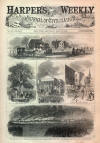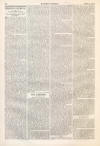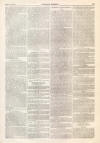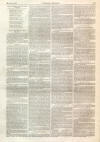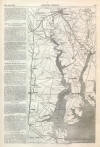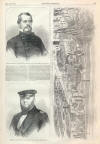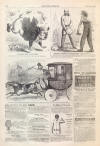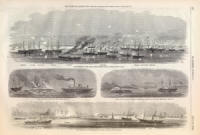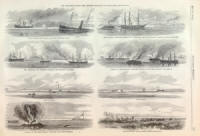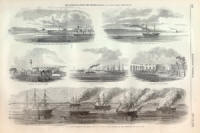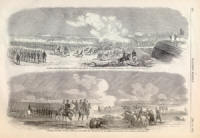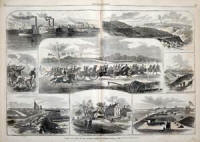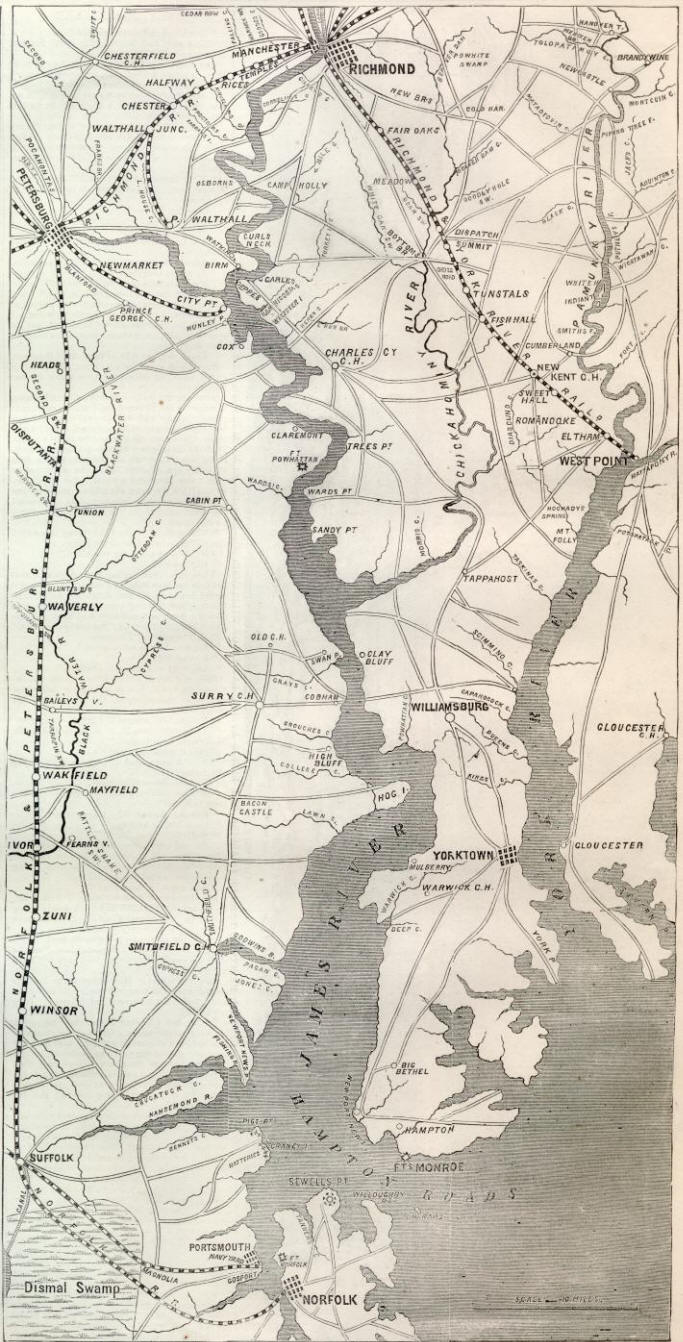pass the awful crime of those
who, for selfish and wicked ends, turned our fertile fields into battle-grounds
and cemeteries, and desolated our homes, as a light thing? Shall we give the
fraternal hand, and offer the kiss of reconciliation, as though all were an
innocent mistake or peccadillo? By the suffering and sorrow that remains
unassuaged, no! Not revenge, not hate, not unforgiveness—no, not these for a
Christian people; but a stern and abiding remembrance of the spirit that
prompted the evils we have endured, and a never-ceasing condemnation of all who
favored it in word or deed.
GENERAL HANCOCK'S CHARGE
AT WILLIAMSBURG.
WE illustrate on
page 332 THE
SPLENDID BAYONET CHARGE OF GENERAL HANCOCK'S BRIGADE at the battle of
Williamsburg, and GENERAL HOOKER'S DIVISION IN THE SAME BATTLE; on
page 333 we
publish a portrait of GENERAL HANCOCK. On this page we publish a MAP OF THE SEAT
OF WAR IN VIRGINIA, showing the country which intervenes between Richmond and
Yorktown. We think we may say that our Map contains every town, road, river,
creek, and considerable village in the section of country where
General McClellan is operating, and where the
last act of the drama of Rebellion will be performed. General Hancock's charge
is thus described in the Herald correspondence:
The rebel general had seen our
weakness, and sent a force of four thousand infantry and a regiment of cavalry
to attack us in the rear. As soon as they appeared in sight General Hancock
ordered the artillery to retreat, and prepared to give them a proper reception.
Waiting till the enemy had
approached within two hundred yards, he placed himself at the head of his
column, and, taking off his cap, turned to his men and said to them, as only
General Hancock can say it, "Gentlemen, charge!" and with a yell they rushed
upon the enemy, scattering them in every direction.
This was probably the most
brilliant charge made during the day. A great number of the enemy were left dead
and wounded upon the field, while our loss was very small.
Our regiments all did nobly, but
none of them more so than the Fifth Wisconsin and Forty-third New York. Colonel
Cobb and Major Larabee, of the Fifth Wisconsin, and Colonels Vinton and Pearson,
of the Forty-third New York, are deserving of especial praise. The charge made
by General Hancock saved us the day yesterday, in all probability. By the time
our reinforcements had arrived General Hancock had driven the enemy from the
field.
GENERAL McCLELLAN'S ARMY.
WE publish on
pages 328 and 329 a
number of pictures illustrating the retreat of the rebels from
Yorktown and the pursuit by General McClellan;
all from sketches by our artist, Mr. A. R. Waud. He writes us as follows of
these sketches:
ROAD
TO THE LAND FACE OF THE YORKTOWN FORTIFICATIONS.
This road leads through a
desolate ravine, where the trees which formerly graced the sides have been cut
down and burned, leaving black trunks and stumps upon the arid soil. An
occasional dead horse, a caisson, a limber-box, and a dreadful stench mark the
principal line of communication between the main works and the Warwick River
defenses. In the distance is Lowe's balloon, taken to Yorktown early Sunday
morning, to discover, if possible, the line of retreat of the secession army.
THE
OLD NELSON HOUSE, YORKTOWN.
This is the largest house in
Yorktown, and takes its name from its former occupant, Judge Nelson. It is of
course in a filthy condition, as indeed is the whole town and its neighborhood
except a portion of the fortifications, which are clean and very perfect.
Cornwallis made this house his head-quarters, and for some time the patriot army
refrained from firing in it, as it was the property of Governor Nelson, who had
already sacrificed the rest of his property to the cause. When he heard of this
he at once went to the trenches, and insisted that his dwelling should not be
spared, training a gun on it, and firing the first shot himself. A dot between
the two upper windows marks the place on the opposite side of the house which
the ball hit.
REBEL MAGAZINE.
The river front of the
fortifications is intersected by several deep ravines, used as covered ways
between the works, and as shelter for the barracks and tents of the soldiers.
They smell badly enough, causing those who inadvertently wander there to hurry
off again as quick as possible. The magazine at the head of this hollow gives it
a tomb-like appearance. What ammunition, if any, there may he in it will be
found when it is certain there are no torpedoes in the way.
EXPLOSION OF A TORPEDO.
These vile arrangements of the
enemy are shells placed under the surface, with a wafer and fuse just reaching
the surface. Stepping on the wafer produces concussion enough to explode it, and
thus cause the destruction of the unfortunate who treads on it. These are said
to have been constructed purposely by G. W. Rains, at the Fayetteville Arsenal,
and were placed about the works by his brother, General Gabriel J. Rains. One of
them was placed in a large pitcher in the hospital, with a string tied to the
table, that would cause its explosion on lifting the pitcher. This was
discovered by some one lifting a piece of oil-cloth laid on the top of the
pitcher to hide the contents.
FORTIFICATIONS OF YORKTOWN, LOOKING TOWARD THE RIVER.
The scene from this point is very
striking. On the top of the bluffs well-built turfed batteries command the water
side. Following the beach we come to the principal water-battery, while on the
distant shore is Farinholt's house, close to which is the Federal Battery No. 1.
of 100 and 200 pounder Parrotts. This battery, worked by the Connecticut boys,
raised a dreadful alarm in the minds of the rebels, and did much to cause their
Skedaddle.
